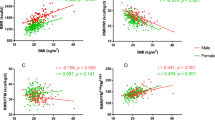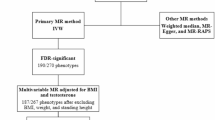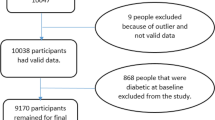Abstract
Objective:
To assess reproducibility and validity of resting metabolic rate (RMR) of Bangladeshi women as measured with the MedGem device and using the Deltatrac metabolic monitor as a reference; and (2) to evaluate the FAO/WHO/UNU basal metabolic rate (BMR)-prediction equations.
Design:
In each of two sessions, resting oxygen consumption was measured in triplicate by MedGem and in triplicate by Deltatrac device.
Setting:
Matlab area, the rural field research area of the Centre for Health and Population Research, Bangladesh (ICDDR,B).
Subjects:
A total of 37 nonpregnant, nonlactating women, aged 27.6±4.5 y, BMI 20.8±3.1 kg/m2 participated.
Results:
The difference in oxygen consumption by MedGem and Deltatrac device was significantly level dependent. Within-subject within-session variations (expressed as CV) were 9.0 and 3.0% (P<0.01) and within-subject between-session variations were 8.2 and 4.5% (P<0.01) for MedGem and Deltatrac, respectively. Mean RMR measured by Deltatrac (5.17±0.51 MJ/day) was not significantly different from the BMR predicted by the FAO/WHO/UNU equations (5.16±0.42 MJ/day) in the second session and only 0.19 MJ/day higher than predicted in the first session (P<0.05).
Conclusion:
Reproducibility and validity of the MedGem device was poor compared to the Deltatrac reference method. The FAO/WHO/UNU BMR-prediction equations give a good estimation of the BMR of rural, nonpregnant, nonlactating Bangladeshi women of 18–35 y.
Sponsorship:
Wageningen University (The Netherlands) and ICDDR,B (Bangladesh).
This is a preview of subscription content, access via your institution
Access options
Subscribe to this journal
Receive 12 print issues and online access
$259.00 per year
only $21.58 per issue
Buy this article
- Purchase on SpringerLink
- Instant access to full article PDF
Prices may be subject to local taxes which are calculated during checkout



Similar content being viewed by others
References
ACC/SCN (1997): Nutrition and Poverty Nutrition policy paper no. 16. Kathmandu: ACC/SCN.
Alam DS, van Raaij JMA, Hautvast JGAJ, Yunus M & Fuchs GJ (2003): Energy stress during pregnancy and lactation: consequences for maternal nutrition in rural Bangladesh. Eur. J. Clin. Nutr. 57, 151–156.
Bland JM & Altman DG (1986): Statistical methods for assessing agreement between two methods of clinical measurement. Lancet i, 307–310.
Durnin JVGA & Womersley J (1974): Body fat assessed from total body density and its estimation from skinfold thickness: measurements on 481 men and women aged from 16–72 years. Br. J. Nutr. 32, 77–97.
FAO (1999): Bangladesh Nutrition country profiles. Rome: FAO.
FAO/WHO/UNU (1985): Energy and Protein Requirements. Technical Report Series no. 724. Geneva: WHO.
Fauveau V (1994): Neonatal and perinatal health in Matlab. In Matlab: Women, Children and Health, ed. V Fauveau, pp 139–160. Dhaka: ICDDR,B.
Ferro-Luzzi A, Petracchi C, Kuriyan R & Kurpad AV (1997): Basal metabolism of weight-stable chronically undernourished men and women; lack of metabolic adaptation and ethnic differences. Am. J. Clin. Nutr. 66, 1086–1093.
Figueroa-Colon R, Franklin FA, Goran MI, Lee JY & Weinsier RL (1996): Reproducibility of measurement of REE in pre-pubertal girls. Am. J. Clin. Nutr. 64, 533–536.
Hayter JE & Henry CJK (1994): A re-examination of basal metabolic rate predictive equations: the importance of geographic origin of subjects in sample selection. Eur. J. Clin. Nutr. 48, 702–707.
Healthetech (2001a): MedGem Indirect Calorimeter. Operator's manual. Golden: Healthetech.
Healthetech (2001b): Comparison of the BodyGem to a Mechanical Simulation Device. Healthetech technical report 002. http://www.healthetech.com/corp/downloads/technical002.pdf(accessed 15 November 2002).
Henry CJK & Rees DG (1991): New predictive equations for the estimation of basal metabolic rate in tropical peoples. Eur. J. Clin. Nutr. 45, 177–185.
ICDDR,B (2002): Nutrition. In ICDDR,B: Centre for Health and Population Research. Annual Report 2001 pp 36–43. Dhaka: ICDDR,B.
Nieman DC, Trone GA & Austin MD (2003): A new handheld device for measuring resting metabolic rate and oxygen consumption. J. Am. Diet. Assoc. 103, 588–593.
Osendarp SJM, van Raaij JMA, Darmstadt GL, Baqui AH, Hautvast JGAJ & Fuchs GJ (2001): Zinc supplementation during pregnancy and effects on growth and morbidity in low birthweight infants: a randomised placebo controlled trial. Lancet 357, 1080–1085.
Schofield WN, Schofield C & James WPT (1985): Basal metabolic rate—review and prediction, together with an annotated bibliography of source material. Hum. Nutr. Clin. Nutr. 39C (Suppl 1), 5–41.
Shetty PS (1984): Adaptive changes in basal metabolic rate and lean body mass in chronic under nutrition. Hum. Nutr. Clin. Nutr. 38C, 443–451.
Shetty PS, Henry CJK, Black AE & Prentice AM (1996): Energy requirements of adults: an update on basal metabolic rates (BMRs) and physical activity levels (PALs). Eur. J. Clin. Nutr. 50 (Suppl 1), S11–S23.
Takala J, Keinänen O, Väisänen P & Kari A (1989): Measurement of gas exchange in intensive care; laboratory and clinical validation of a new device. Crit. Care Med. 17, 1041–1047.
Tissot S, Delafosse B & bertrand O (1995): Clinical validation of the Deltatrac monitoring system in mechanically ventilated patients. Intern. Care Med. 21, 149–153.
Ventham JC & Reilly JJ (1999): Reproducibility of resting metabolic rate measurement in children. Br. J. Nutr. 81, 435–437.
Weir JB de V (1949): New methods for calculating metabolic rate with special reference to protein metabolism. J. Physiol. 109, 1–9.
Weissman C, Sardan A & Kemper M (1990): In vitro evaluation of a compact metabolic measurement instrument. J. Parenter. Enteral. Nutr. 14, 216–221.
Wernimont GT (1985): Use of Statistics to Develop and Evaluate Analytical Methods: Interlaboratory Evaluation of an Analytical Process. Arlington: AOAC International.
Acknowledgements
This research was supported by the Poverty and Health grant of the Department for International Development (DFID), UK (Grant Number 00230) to ICDDR,B: Centre for Health and Population Research. ICDDR,B acknowledges with gratitude the commitment of DFID to the Centre's research effort. We are grateful to the ICDDR, B staff that gave full support to this study, and to Shamsun Naher, Rokeya Akter, Rashida Akter and Ramjan Ali for their valuable contribution to data collection.
Author information
Authors and Affiliations
Corresponding author
Additional information
Guarantor: PJM Hulshof.
Contributors: DSA, JvR and PH conceptualized and supervised the study and developed the analysis plan. MM, DR, MY and MAS assisted with the study design. MM and DR led the data collection and analysis and provided support for the manuscript preparation. All authors critically revised the first draft for content and contributed to the final draft. No authors had any financial or personal interest in the research conducted.
Rights and permissions
About this article
Cite this article
Alam, D., Hulshof, P., Roordink, D. et al. Validity and reproducibility of resting metabolic rate measurements in rural Bangladeshi women: comparison of measurements obtained by Medgem™ and by Deltatrac™ device. Eur J Clin Nutr 59, 651–657 (2005). https://doi.org/10.1038/sj.ejcn.1602122
Received:
Revised:
Accepted:
Published:
Issue date:
DOI: https://doi.org/10.1038/sj.ejcn.1602122
Keywords
This article is cited by
-
Low resting energy expenditure in postmenopausal Japanese women with type 2 diabetes mellitus
Diabetology International (2019)
-
Intermittent fasting, energy balance and associated health outcomes in adults: study protocol for a randomised controlled trial
Trials (2018)
-
Comparison of five equations for estimating resting energy expenditure in Chinese young, normal weight healthy adults
European Journal of Medical Research (2012)
-
Body circumferences are predictors of weight adjusted resting energy expenditure in older people
The Journal of nutrition, health and aging (2011)



